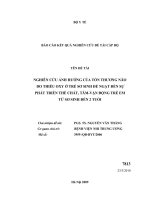Nghiên cứu ảnh hưởng của Kinh tế xã hội đến các yếu tố nguy cơ của các nhóm bệnh tim mạch ở người dân tộc Naxi Vân Nam_Trung Quốc
Bạn đang xem bản rút gọn của tài liệu. Xem và tải ngay bản đầy đủ của tài liệu tại đây (973.26 KB, 15 trang )
Socioeconomic influence on clustering of cardiovascular risk factors
among Naxi ethnic minority in Yulong county of Yunnan province
Name: Cao Feng
Tutor: Professor Cai Le
Major: Social medicine and health service
management
Institution: School of Public Health, Kunming Medical
University, Kunming, Yunnan Province
Background
Aims
Methods
Results
Conclusion
One
Background
Cardiovascular disease(CVD)
Present situ
ation of ove
rsea
Present sit
uation of Ch
ina
Cardiovascular disease(CVD)
Cardiovascular disease is caused by disorders of the heart and blood
vessels, and includes coronary heart disease (heart attacks),
cerebrovascular disease (stroke), raised blood pressure
(hypertension), peripheral artery disease, rheumatic heart disease,
congenital heart disease and heart failure.
The major risk factors of CVD
There are more than 300 known CVD risk factors. The major causes of
cardiovascular disease are tobacco use, physical inactivity, an
unhealthy diet and harmful use of alcohol.
Cardiovascular
disease has
become the
leading cause of
death in the world
80% of the CVD
occurred in low and middleincome countries
Economic burden
of cardiovascular
disease has risen
sharply
Present
situation
of overs
ea
Cardiovascular
disease risk
factors of
socioeconomi
c influence
study has
received wide
recognition
Total mortality of
cardiovascular
disease showed a
trend of a
significant increase
Total population
prevalence of
cardiovascular
disease continues
to rise
Ethnic groups had
different
cardiovascular
disease epidemic
situation
Present
situation
of China
Data on the
relationship
between
socioeconomic
determinants
and
cardiovascular
risk factors
among ethnic
minorities
Two
Aims
To analyze socioeconomic influencing determinants of
CVD risk factors among Naxi ethnic minority in Yulong
county of Yunnan province.
Three
Methods
1. Stratified random sampling was used to select a
representative sample of 1402 Naxi ethnic minority
aged 35 and over from Yulong county.
2. Information was obtained from a cross-sectional
questionnaire and health examination survey.
3.Descriptive statistical analysis were used for the
basic situation of people surveyed and the
constitutents of different risk factors .
4. Chi-Square was undertaken for exploring the
association between clustering of CVD risk factors and
socioeconomic position.
Risk factor measurements
risk
factor
overweight
alcohol drinking
family history
central obesity
smoking
depression
obesity
secondhand smoke
exposure
life pressure
hypertension
high salt diet
physical inactivity
diabetes
Measure of socioeconomic status
Socioeconomic status was measured by six main
indicators: householder; level of education; tap water
in the home; toilet in the home; housing situation;
per-capita income.
Results
Four
Table1: Incidence of CVD risk factor of different gender Naxi
residents
risk factor
Male
Female
Total sample
n
%
n
%
n
%
overweight
163
25.3
202
26.6
365
26.0
obesity
43
6.7
82
10.8**
125
8.9
central obesity
128
19.9
426
56.2**
554
39.5
hypertension
155
24.1
213
28.1
368
26.2
diabetes
27
4.2
31
4.1
58
4.1
smoking
452
70.2*
9
1.2
461
32.9
alcohol drinking
313
48.6*
30
4.0
343
24.5
CVD family history
62
9.6
83
10.9
145
10.3
high salt diet
183
28.4
201
26.5
384
27.4
secondhand smoke
exposure
63
9.8
242
31.9**
305
21.8
life pressure
54
8.4
76
10.0
130
9.3
depression
16
2.5
57
7.5**
73
5.2
physical inactivity
209
32.5
243
32.1
452
32.3
Compared with women , men had higher incidence rate in smoking and alcohol
drinking(p<0.05).
**
Compared with men, women had higher incidence rate in obesity, central obesity,
secondhand smoke exposure and depression(p<0.05).
*
Results
Four
Table2: Clustering of CVD risk factors of Naxi particiants by sex and
age
Age
Gender
clustering of
cardiovascular
risk factors
Male
35-44y
Female
45-59y
≥60y
n
%
n
%
n
%
n
%
n
%
0
20
3.1
67
8.8*
33
8.1
36
6.7
18
3.9
1-2
265
41.1
332
43.8
203
50.1
212
39.6
182
39.4
≥3
359
55.7**
359
47.4
169
41.7
287
53.6***
262
56.7***
Compared with male , female had higher proportion without clustering of CVD risk
factors(p<0.01).
**
Compared with female, The proportion of clustering of more than 3 risk factors was
higher in men(p<0.01).
***
Compared with35-44y, The proportion of clustering of more than 3 risk factors was
higher in45-54y and ≥60y(p<0.01).
*
Four
Results
Table3: Chi-Square on association between socioeconomic indicator/status
and Clustering of CVD risk factors
Clustering of cardiovascular risk factors
Socioeconimic
indicator
0
1-2
3
n
%
n
%
n
%
No
27
4.4
257
41.7
332
53.9
Yes
60
7.6
340
43.3
386
49.1
Illiteracy
5
2.6
72
37.1
117
60.3
Primary
25
7.0
169
47.3
163
45.7
Secondary and above
57
6.7
356
41.8
438
51.5
Low
25
4.8
203
39.0
292
56.2
Middle
32
5.6
255
44.3
289
50.2
High
30
9.8
139
45.4
137
44.8
P
Householder:
0.022*
level of education
0.009*
Socioeconimic status
0.003*
Householder, people with higher level of education and higher socioeconomic position
had lower level of clustering of CVD risk factors (P<0.05).
*
Five
Conclusion
The findings indicate a
higher level of clustering of
CVD risk factors among Naxi
ethnic minority people in
Yunnan province.
1. Popularize the health
education
2. Improve economic
performance
3. Enhancing public education
level
Comprehensive prevention and control of CVD should more
foucs on male Naxi residents.
Future prevention and intervention strategies of CVD
should more focus on non head of household, individuals with
low level of education and low socioeconomic position.
THANK YOU FOR YOUR ATTENTION









